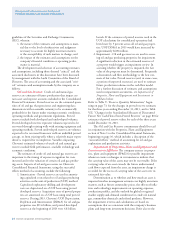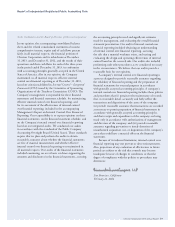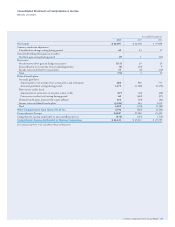Chevron 2013 Annual Report Download - page 26
Download and view the complete annual report
Please find page 26 of the 2013 Chevron annual report below. You can navigate through the pages in the report by either clicking on the pages listed below, or by using the keyword search tool below to find specific information within the annual report.
Management’s Discussion and Analysis of
Financial Condition and Results of Operations
24 Chevron Corporation 2013 Annual Report
guidelines of the Securities and Exchange Commission
(SEC), wherein:
1. the nature of the estimates and assumptions is mate-
rial due to the levels of subjectivity and judgment
necessary to account for highly uncertain matters
orthe susceptibility of such matters to change; and
2. the impact of the estimates and assumptions on the
company’s nancial condition or operating perfor-
mance is material.
e development and selection of accounting estimates
and assumptions, including those deemed “critical,” and the
associated disclosures in this discussion have been discussed
by management with the Audit Committee of the Board of
Directors. e areas of accounting and the associated “criti-
cal” estimates and assumptions made by the company are as
follows:
Oil and Gas Reserves Crude oil and natural gas
reserves are estimates of future production that impact cer-
tain asset and expense accounts included in the Consolidated
Financial Statements. Proved reserves are the estimated quan-
tities of oil and gas that geoscience and engineering data
demonstrate with reasonable certainty to be economically
producible in the future under existing economic conditions,
operating methods and government regulations. Proved
reserves include both developed and undeveloped volumes.
Proved developed reserves represent volumes expected to be
recovered through existing wells with existing equipment and
operating methods. Proved undeveloped reserves are volumes
expected to be recovered from new wells on undrilled proved
acreage, or from existing wells where a relatively major expen-
diture is required for recompletion. Variables impacting
Chevron’s estimated volumes of crude oil and natural gas
reserves include eld performance, available technology and
economic conditions.
e estimates of crude oil and natural gas reserves are
important to the timing of expense recognition for costs
incurred and to the valuation of certain oil and gas produc-
ing assets. Impacts of oil and gas reserves on Chevron’s
Consolidated Financial Statements, using the successful
eorts method of accounting, include the following:
1. Amortization - Proved reserves are used in amortiz-
ing capitalized costs related to oil and gas producing
activities on the unit-of-production (UOP) method.
Capitalized exploratory drilling and development
costs are depreciated on a UOP basis using proved
developed reserves. Acquisition costs of proved proper-
ties are amortized on a UOP basis using total proved
reserves. During 2013, Chevron’s UOP Depreciation,
Depletion and Amortization (DD&A) for oil and gas
properties was $11.6 billion, and proved developed
reserves at the beginning of 2013 were 4.8 billion
barrels. If the estimates of proved reserves used in the
UOP calculations for consolidated operations had
been lower by 5 percent across all oil and gas proper-
ties, UOP DD&A in 2013 would have increased by
approximately $600 million.
2. Impairment - Oil and gas reserves are used in assess-
ing oil and gas producing properties for impairment.
A signicant reduction in the estimated reserves of
a property would trigger an impairment review. In
assessing whether the property is impaired, the fair
value of the property must be determined. Frequently,
a discounted cash ow methodology is the best esti-
mate of fair value. Proved reserves (and, in some cases,
a portion of unproved resources) are used to estimate
future production volumes in the cash ow model.
For a further discussion of estimates and assumptions
used in impairment assessments, see Impairment of
Properties, Plant and Equipment and Investments in
Aliates below.
Refer to Table V, “Reserve Quantity Information,” begin-
ning on page 73, for the changes in proved reserve estimates
for the three years ending December 31, 2013, and to Table
VII, “Changes in the Standardized Measure of Discounted
Future Net Cash Flows From Proved Reserves” on page 80 for
estimates of proved reserve values for each of the three years
ended December 31, 2013.
is Oil and Gas Reserves commentary should be read
in conjunction with the Properties, Plant and Equipment
section of Note 1 to the Consolidated Financial Statements,
beginning on page 36, which includes a description of the
“successful eorts” method of accounting for oil and gas
exploration and production activities.
Impairment of Properties, Plant and Equipment and
Investments in Affiliates e company assesses its proper-
ties, plant and equipment (PP&E) for possible impairment
whenever events or changes in circumstances indicate that
the carrying value of the assets may not be recoverable. If the
carrying value of an asset exceeds the future undiscounted
cash ows expected from the asset, an impairment charge is
recorded for the excess of carrying value of the asset over its
estimated fair value.
Determination as to whether and how much an asset is
impaired involves management estimates on highly uncertain
matters, such as future commodity prices, the eects of ina-
tion and technology improvements on operating expenses,
production proles, and the outlook for global or regional
market supply-and-demand conditions for crude oil, natural
gas, commodity chemicals and rened products. However,
theimpairment reviews and calculations are based on
assumptions that are consistent with the company’s business
plans and long-term investment decisions. Refer also to the
























